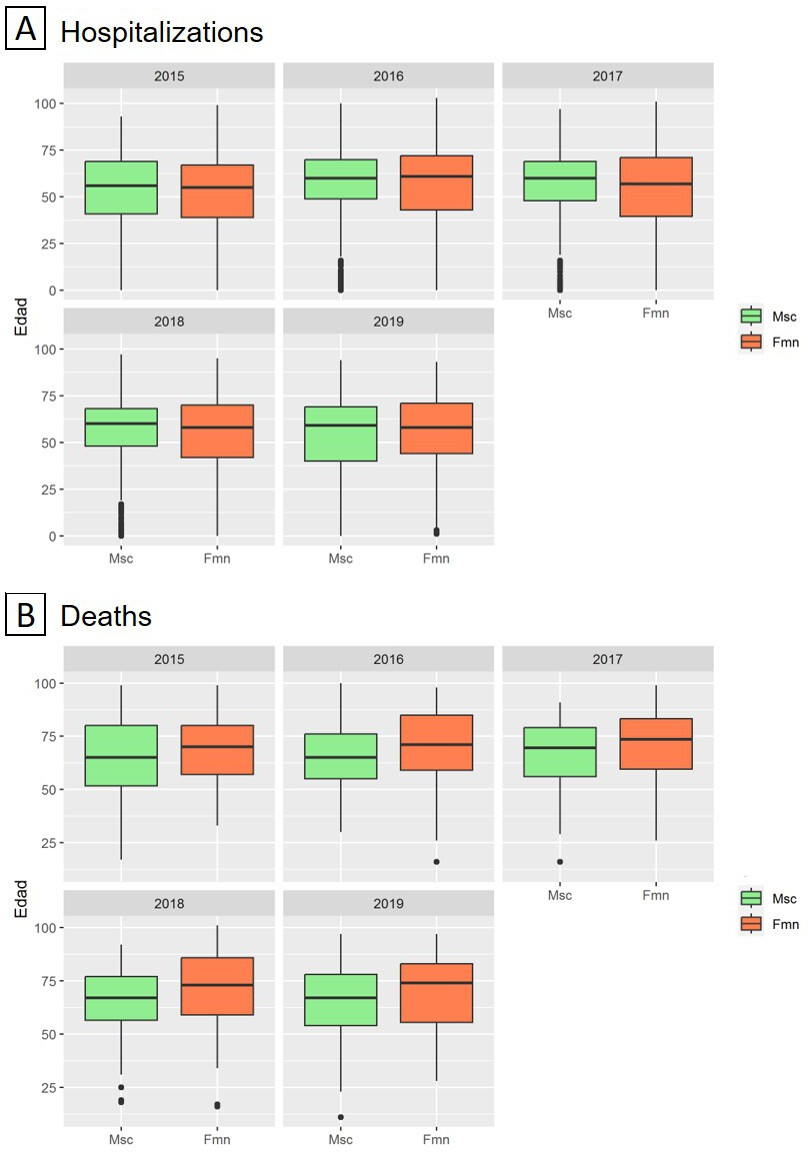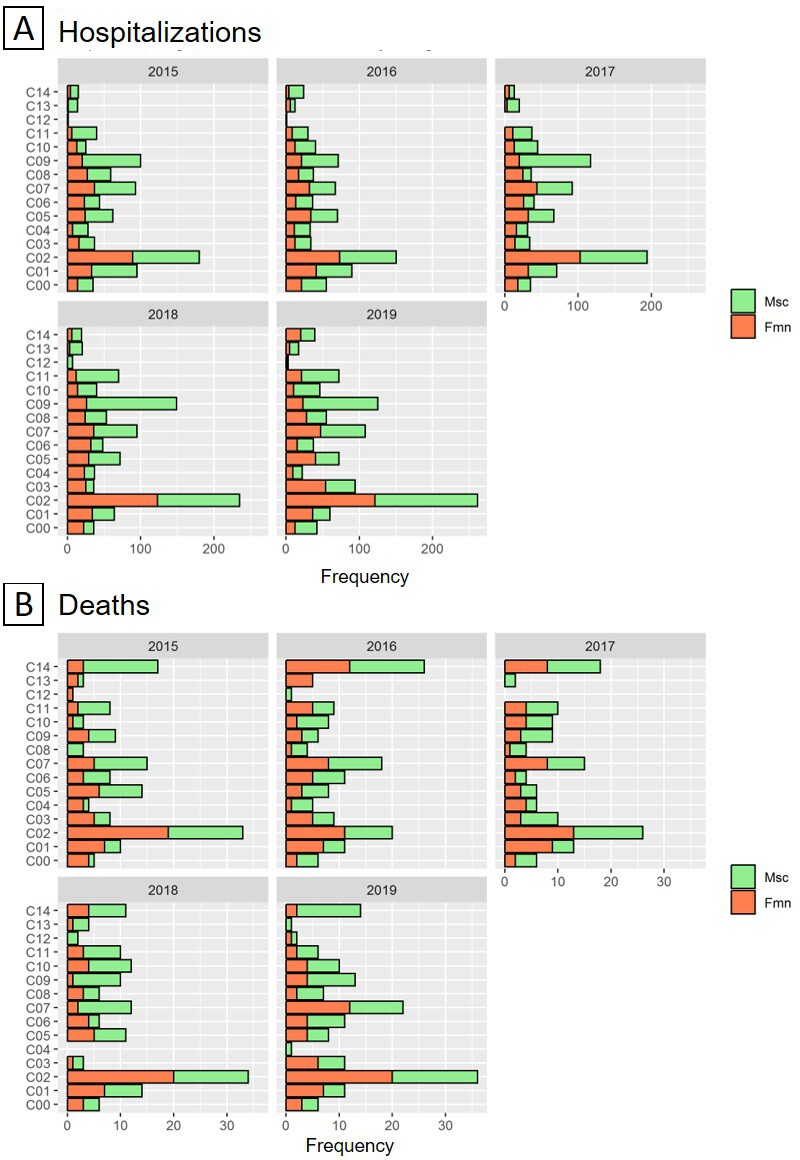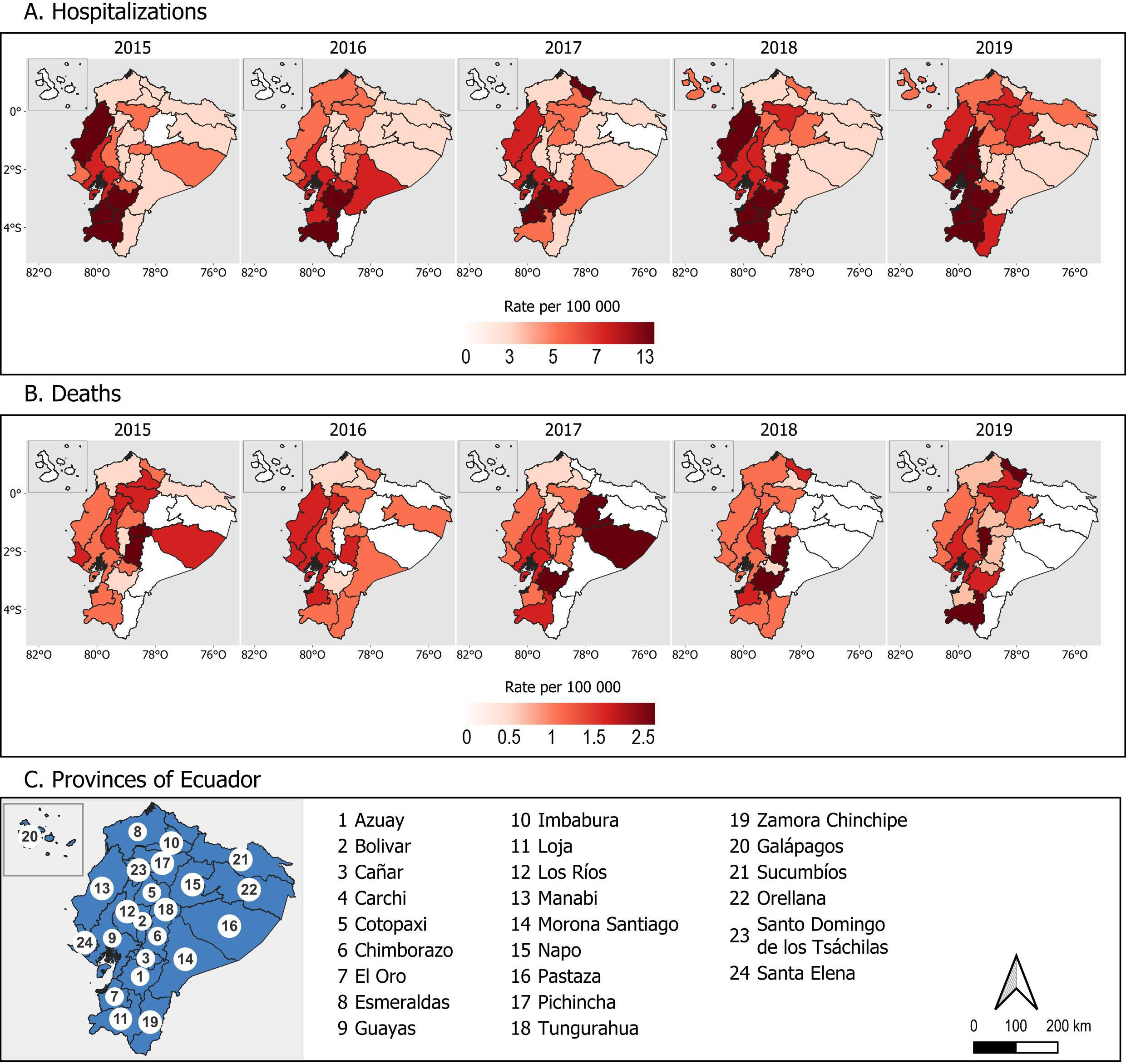Estudios originales
← vista completaPublicado el 1 de abril de 2025 | http://doi.org/10.5867/medwave.2025.03.3024
Distribución de las neoplasias malignas de la cavidad oral en Ecuador: estudio epidemiológico de 2015 a 2019
Distribution of malignant neoplasms of the oral cavity in Ecuador: an epidemiological study from 2015 to 2019
Abstract
Introduction Malignant neoplasms of the oral cavity represent a public health problem worldwide with an increasing incidence, especially in young populations. In Ecuador, the epidemiology of these conditions has been little studied, limiting timely diagnosis and management. The study aims to identify the distribution of hospitalizations and deaths from oral cavity malignant neoplasms in Ecuador during the pre-pandemic years, from 2015 to 2019, describing spatiotemporal patterns by province, gender, and age.
Methods An observational and descriptive study was conducted using the database of hospitalizations and deaths of the National Institute of Statistics and Census of Ecuador. Variables such as age, gender, province, and location of the neoplasms were analyzed, and frequencies, proportions, and crude rates were calculated.
Results Between 2015 and 2019, 4444 hospitalizations and 726 deaths were reported, with a notable increase in 2019. Males predominated in all the studied years. Malignant neoplasms of unspecified sites and other sites of the tongue had the highest frequency of cases and deaths. Geographically, the provinces of Loja, El Oro, Cañar, Carchi, and Bolivar had the highest rates.
Conclusions The study shows an increase in hospitalizations and deaths due to malignant neoplasms of the oral cavity between 2015 and 2019, highlighting the urgency of implementing public health strategies aimed at prevention, early detection, and timely treatment of this disease.
Main messages
- Malignant neoplasms of the oral cavity are an increasingly relevant public health problem, with a worrying trend towards affecting younger populations.
- In Ecuador, there has been an increase in hospitalization rates and deaths from malignant neoplasms of the oral cavity during the period from 2015 to 2019, with a notable increase in the provinces of Loja, El Oro, and Azuay for hospitalizations and in Azuay, Loja, Carchi and Bolívar for deaths.
- The study’s limitations include potential biases in the data and a lack of information on specific regional risk factors.
Introduction
The oral cavity is derived embryologically from the first branchial arch and the superficial ectoderm. It is lined by stratified squamous epithelium whose homeostasis depends on mechanisms that regulate the cell cycle and differentiation [1]. The alteration of these mechanisms through mutations in tumor suppressor genes and oncogenes can trigger the development of malignant neoplasms such as cancer of the lip, oral cavity, and pharynx [2]. According to data from the Global Cancer Observatory (GLOBOCAN), in 2020, these pathologies accounted for 4.1% of total cancer cases and 3.7% of cancer-related deaths [3]. Furthermore, their incidence has increased in young populations over recent decades [4], rendering these neoplasms a global public health concern [5].
Malignant neoplasms of the oral cavity show significant differences between genders, with a greater impact on men [6], which is mainly associated with the consumption of tobacco and alcohol, predominant risk factors in this group. However, the increase in these habits in women could modify the trends in the future [7]. Other risk factors, such as human papillomavirus (HPV) infection, are more strongly associated with these neoplasms in women [7]. Although malignant neoplasms of the oral cavity are a disease with similar clinical characteristics in both genders, there are variations in certain subtypes, such as squamous cell carcinoma of the tongue, which is also more common in women [5].
In Ecuador, there are few up-to-date studies on the epidemiology of malignant neoplasms of the oral cavity, which, to a certain extent, limits the capacity to implement effective prevention and control strategies. A previous study examining trends and spatial patterns from 2001 to 2016 revealed an increase in mortality, particularly among individuals in the 30 to 39 and 40 to 49 age groups [8]. The lack of information, awareness, and adequate training of dental professionals has had an impact on the timely diagnosis and effective management of the disease [9].
Given this context, the objective of this study is to identify the distribution of hospitalizations and deaths from malignant neoplasms of the oral cavity in Ecuador during the pre-pandemic years from 2015 to 2019. It also seeks to visualize spatio-temporal patterns by province, gender, and age to describe the situation of this group of conditions in the country, guiding public health strategies and providing hypotheses for future studies.
Methods
Study design
An observational and descriptive epidemiological study was carried out on malignant neoplasms of the oral cavity in Ecuador, focusing on the pre-pandemic period from 2015 to 2019. This design also made it possible to visualize the spatio-temporal patterns associated with this group of diseases across the 24 provinces of Ecuador.
Data sources
We used the administrative records of hospitalizations and general deaths from the National Institute of Statistics and Censuses [10,11]. Malignant neoplasms of the oral cavity were defined according to the Tenth Revision of the International Classification of Diseases (ICD-10), encompassing codes C00 to C14 (Table 1).
Data processing and visualization of spatio-temporal patterns
To account for all patients who were admitted to the hospital and died in the pre-pandemic period, we merged the available annual databases, filtering the records by year of admission and death. We excluded records that did not have a residence in Ecuador because they lacked a code associated with a specific province of residence, which made it difficult to assign these cases to a particular geographical location. In total, 4444 hospitalizations and 726 deaths were analyzed.
With this consolidated base, a descriptive analysis of the data was conducted at the national level. This included calculating frequencies and percentages for each of the variables: year, age, and location of the neoplasm, broken down by gender (male and female). The data was presented in the form of tables and graphs. All data processing was performed using the R software.
In terms of spatio-temporal patterns, the data was grouped by year and province of residence. With this, the crude rate was calculated by dividing the total number of hospitalizations or deaths by the total population of each province and for each year. The result was multiplied by 100 000 to express the rate per hundred thousand inhabitants. Subsequently, the data was spatialized using the QGIS Geographic Information System (GIS), using the administrative boundaries of each province as a geographic basis to associate hospitalizations and deaths with their respective areas.
Results
Between 2015 and 2019, 4444 hospitalizations and 726 deaths from malignant neoplasms of the oral cavity were recorded in Ecuador. Of these, 58.7% corresponded to males and 41.3% to females. Hospitalizations showed an upward trend throughout the study period, reaching their highest frequency in 2019 with 1053 cases, which represents 24% of total hospitalizations. On the other hand, deaths showed a gradual increase during the same period, reaching 159 cases in 2019, equivalent to 22% of total deaths (Table 2).
Regarding age, hospitalizations are primarily distributed in the 50 to 59 (19%) and 60 to 69 (22%) groups, with a higher representation of males (60.67% and 66.02%, respectively). In comparison, deaths are mainly concentrated in the 70 to 79 (21%) and 80 to 89 (20%) age groups, with the latter group having a higher frequency of women (52.03%) compared to men (47.97%) (Table 3). The box plots indicate a broader age distribution for hospitalizations compared to deaths. In addition, it can be seen that the median age for hospitalizations is 50 and 60 years for both genders, while for deaths, it is considerably higher, with medians of 60 and 75 years being slightly higher in women (Figure 1).
Age distribution of hospitalized and deceased patients in Ecuador by year, gender, and age.

Source: Prepared by the authors.
Regarding the location of malignant lesions, hospitalizations were more frequent for malignant neoplasms of other and unspecified parts of the tongue, accounting for 23% of all cases, as well as for malignant neoplasms of the tonsil, which constituted 13% of the total. Tongue neoplasms affected men and women almost equally, with rates of 50.1% and 49.9%, respectively. In contrast, tonsillar neoplasms were more prevalent in men, accounting for 80.4% of the cases (Table 4). By year, malignant neoplasms of the parotid gland also showed an increasing trend (Figure 2A).
Absolute frequency of hospitalizations and deaths from neoplasms of the oral cavity by year, gender, and location.

Source: Prepared by the authors.
Malignant neoplasms of the tongue (C02) accounted for the highest percentage of deaths, 21%, affecting women slightly more (55.7%) (Table 4). Another prominent location was malignant neoplasms of other and ill-defined sites of the lip, oral cavity, and pharynx (C14), with 12% of cases. These have maintained a constant prevalence over the years, especially in 2015, 2016, and 2017. Likewise, malignant neoplasms of the parotid gland (C07), although not predominant, were reported with significant frequency in specific years, particularly in 2018 and 2019 (Figure 2B).
In terms of hospitalization rates by province (Figure 3A), Loja had the highest rates compared to the others. However, it experienced a significant decrease in 2017 (5 per 100 000 inhabitants), followed by a rise, and reached its highest point in 2019 (12 per 100,000 inhabitants). El Oro and Azuay also showed high rates, especially during 2017 (11 per 100 000 inhabitants). On the other hand, death rates (Figure 3B) were lower than hospitalization rates, with variations over time. In 2019, Loja, Carchi, and Bolívar showed a higher increase. In Azuay, the death rate rose from 0.49 per 100 000 inhabitants in 2015 to 1.78 in 2017, while Chimborazo had notable peaks in 2015 and 2018 with rates of 1.59 and 1.55, respectively.
Annual evolution of the crude rate of hospitalizations and general deaths by province of residence.

Source: Prepared by the authors
Discussion
During the analyzed period in Ecuador, there was a significant increase in hospitalizations and deaths related to malignant neoplasms of the oral cavity, reaching a peak in 2019 with 1053 (24%) hospitalizations and 159 (22%) deaths. This increase was particularly notable in the provinces of Loja, El Oro, and Azuay in terms of hospitalizations, and in Carchi and Bolívar, in terms of deaths. Malignant neoplasm of other and unspecified parts of the tongue was the main location for both hospitalizations and deaths.
Mortality from malignant neoplasms of the oral cavity in Ecuador has increased in recent years, with an increase from 141 (19%) deaths in 2015 to 159 (22%) in 2019, in absolute terms. This upward trend coincides with previous findings in the region, which report an increase of 53 deaths between 2001 and 2016 [8]. Likewise, studies conducted in the United States have shown a recent increase in the trends of malignant neoplasms of the oral cavity [12,13] despite a decrease in previous decades [14]. Additionally, it has been confirmed that the risk of malignant neoplasms of the oral cavity increases with age, and the tongue is the most common anatomical site affected [15]. The differences observed between the proportions of hospitalizations for malignant neoplasms of the tongue (23%) and the tonsil (13%), compared to the predominant causes of death from malignant neoplasms of the tongue (21%) and C14 (12%), could be explained by the nature of the diagnoses and the time at which they are recorded. Code C14 corresponds to “malignant neoplasia of other sites and the ill-defined sites of the lip, oral cavity, and pharynx”, which suggests that in the cases of death, cancer may have spread or advanced to a stage where the primary location is no longer clear. On the other hand, hospital diagnoses (malignant neoplasms of the tongue and tonsils) may represent more localized and treatable cases, which explains their higher proportion of hospitalizations.
Regarding the distribution of trends by gender, the study confirms that malignant neoplasms of the oral cavity are more common in men (58.7% hospitalizations and 54.82% deaths), probably due to the higher prevalence of smoking and alcohol consumption [16,17,18], known risk factors. However, there has also been an increase in hospitalizations (from 315 in 2015 to 442 cases in 2019) and deaths (from 65 in 2015 to 71 in 2019) in women [19,20,21], which could be related to changes in these harmful habits [22,23,24], and other factors such as human papillomavirus infection as proposed by various studies [25,26]. However, this contrasts with research suggesting that human papillomavirus-associated oropharyngeal cancer is more common in men [5,27]. Another possible explanation for the increased frequency of malignant neoplasms in women is psychological factors. It is well known that women today are exposed to higher levels of chronic stress due to work pressure, family responsibilities, and adverse life events. According to recent studies, prolonged psychological stress, together with anxiety and depression, can influence the body’s immune and hormonal response, increasing vulnerability to the development and progression of certain types of cancer. Still, there is no specific evidence for oral neoplasms [28]. This highlights the need for further research to explore the relationship between malignant neoplasms of the oral cavity and risk factors according to gender.
The space-time pattern of malignant neoplasms of the oral cavity reveals that Azuay, El Oro, and Loja have the highest hospitalization rates. In contrast, Azuay, Loja, Carchi, and Bolívar have the highest death rates. This pattern differs from that reported in a study carried out from 2001 to 2016, which showed low mortality rates from malignant neoplasms of the oral cavity in Azuay and Loja [8]. This could be related to social and demographic factors specific to the region, considering that Azuay is the third province with the highest percentage of the population identifying as part of diverse communities, which may influence health behavior patterns and access to medical services.
The study’s results have significant implications for public health policy and clinical practice in Ecuador. It is essential to investigate the factors that have contributed to the observed changes, including oral health habits, preventive practices, and access to early detection programs. In addition, it is relevant to explore how cultural, socioeconomic, and structural discrimination factors could impact mortality from oral neoplasms. This highlights the importance of implementing public health strategies that are inclusive and consider the specific needs of diverse populations in the most affected provinces. This should promote equity in access to information, prevention, and treatment of these diseases.
This work can also contribute to the design of prevention and early detection strategies in high-risk areas, promote healthy lifestyles, and raise awareness among the population about the importance of regular visits to health professionals and the associated risk factors. In addition, they emphasize the need to strengthen prevention activities through continuous training programs for oral health professionals, including tools for early detection and timely management of the disease. This is particularly relevant in regions where there has been an increase in hospitalizations and deaths. The implementation of clear and effective health policies, led by those responsible for public health institutions, is crucial to guarantee the promotion of health in general and more robust epidemiological surveillance. It is also crucial to update epidemiological databases to facilitate the continuous surveillance of malignant neoplasms of the oral cavity and other public health problems. This enables more effective responses to emerging trends, thereby improving clinical care and health policies nationwide.
These results aim to provide an overview of the epidemiological trends of malignant neoplasms of the oral cavity in various provinces of Ecuador, highlighting the usefulness of georeferencing for resource planning and intervention implementation. Furthermore, by utilizing existing data, this study enables a comprehensive and accessible analysis of the emerging patterns in the geographical distribution of these diseases, thereby contributing to evidence-based decision-making and the optimization of public health resources [29].
Despite the relevance of these findings, it is essential to consider the study’s limitations, including potential information biases resulting from the use of secondary data and the underreporting of cases [30]. The latter is particularly evident in the hospitalization data, which tends to include mainly the most serious cases that reach hospitals. In the case of mortality data, underreporting may be due to the inaccurate identification of the primary cause of death. However, underreporting is less likely in mortality data due to the legal obligation to report deaths, which ensures greater completeness in these records. Similarly, since these are national data, the records undergo several stages of validation, which enables the calculated mortality rates to be reliable indicators for comparison between regions and over time.
Another limitation of this study is that the COVID-19 pandemic period has not been considered in the trends. Updating the analysis to include the pandemic period would be crucial to understanding how control measures may have influenced the frequency, detection, and treatment of this disease. Future studies could focus on analyzing socioeconomic and geographic disparities, identifying barriers to accessing medical care, and developing interventions for vulnerable groups. Long-term research is also recommended to monitor trends in oral cavity malignancies and to evaluate the impact of interventions on public health and clinical practice.
Conclusions
The descriptive analysis shows a notable increase in hospitalizations and deaths from malignant neoplasms of the oral cavity in Ecuador between 2015 and 2019. Malignant neoplasms of the tongue, tonsil, and parotid gland were the most frequent, especially in men, which suggests the need to expand epidemiological surveillance efforts for this pathology.
The results show a wide distribution of affected ages, primarily concentrated in middle and advanced age groups. This reinforces the importance of timely detection in these groups, as well as promoting healthy lifestyles and raising awareness of the associated risk factors.
At a geographical level, the disparities in hospitalization and death rates in provinces such as Loja, El Oro, Azuay, Carchi, and Bolívar highlight the need for a localized response adapted to the particularities of each region. These findings highlight the importance of implementing public health policies that include prevention, education, and access to early diagnosis and specialized treatment for malignant neoplasms of the oral cavity.

